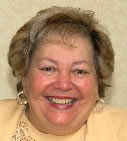  
|
THE WOMEN BUY "LIPNSHTIFT"*
*The Yiddish word for lipstick is "lipnshtift"
  
|

I've been reading the headlines from various newspapers
and "zhurnals."
"Lipsticks Can Tell If An Economy 's Doing Good, or Bad"
"Hard Times, but Your Lips Look Great"
"Tough times call for expensive lipstick"
"Cold Economy Warms Lipstick Sales"
"Lipstick, is economic lull-proof"
"Lipstick is one of the most commonly shoplifted items"
"That Dior Kiss lip gloss almost sounds like a face lift"
"$62,000 Diamond-Studded Lipstick Screams Haute Couture"
"Stila launches "Rock the Vote Red" lipstick ($17) at www.Stilacosmetics.com.
25% of proceeds from the first 500 sales will benefit Rock the Vote,
an organization devoted to mobilizing young people to political participation."
"Grace Kelly appeared in ads for Max Factor Colorfast Lipstick"
"Vos tut zikh"? (What's going on?) Is there
a correlation between a tough economy
and stellar "lipnshtift" sales? Yes!
The use of lipstick is not new. It has been in
vogue for the last "finf toyznt" (50,000)
years. The dye of the Henna plant was used
to redden lips in the "fartsaytik" (ancient) times. Cleopatra was rumoured to
have used crushed beetles in a base of crushed
ants to paint the lips.
There's a lot of history behind "lipnshtift":
When soldiers returned home from "milhome" (war) zones, women needed to
paint on "happy faces" to boost their morale. At that time Revlon began
their "Fire and Ice Campaign." Ads about lipsticks were never the same
again!
In 1946, Americans spent nearly $30 million
for 5,000 tons of lipstick
In 1949, Hazel Bishop, after a long series of
home experiments, perfected a lipstick that
stayed on the lips longer than any other
product available at the time. The following
year she formed Hazel Bishop, Inc. to
manufacture her "Lasting" also known was "Kissable" lipstick. The
lipstick was a great success and other manufacturers
introduced similar products.
In the "yor" 1957, Gala of London came up
with the first lipstick packed in a tube; it
was similar to what we have today.
In 1958, Max Factor said, "A woman who
does not wear lipstick feels undressed in
public unless she works on a farm." The
result? Lipstick consumption soared. No
woman would want to feel "under dressed."
There's an "interesant" term, "lipstick
indicator." It's a noun meaning "The tendency for lipstick sales to increase
prior to and during a recession."
According to Dr. Jane Greer, a New York
psychologist, "shopping can contribute to
your psychological health in times of stress."
Women see lipstick, which sells for as little
as $1.99 at a supermarket to $20 plus at a
department store, as a reasonable indulgence. It's a pick-me-up that
they CAN
afford when they CAN'T afford a Manolo
Blahnik "PIcor" Sandal for $745.
According to Leonard Lauder of Estee Lauder, "When lipstick sales go up,
people don't want to buy dresses." He also saw
his company selling more lipstick after the
Sept. 11, 2001 terrorist attacks. Lauder's
hypothesis: When times are shaky, sales
get a bump up when women want to boost
their mood with relatively inexpensive
lipstick purchases instead of dropping $500
for shoes.
A second term, "lipstick effect," states that
during a recession, there is the tendency for consumers to purchase small,
comforting items such as lipstick rather than large "luksus" (luxury) items.
The Wall Street Journal--and other newspapers--
report that between August and October,
2002, lipstick sales were up 11 percent over
the same period the year before.
And Dr. Noel Lim says, "Our data shows that for every 1% increase in the
unemployment rate, women buy $25 million more lipsticks during the year."
UPI.com (May 5, 2008) writes that "Lipstick
sales pump up during shaky times." That
cute little $280 top may be getting passed
over as the U. S. economy sours, but women
may be buying more lipstick, market
researchers say...Second, the companies
believe in down times women will continue
to splurge on their lips--even as they wear
last year's styles.
_________________________________________
Marjorie Wolfe agrees with her sister-in-law, Myrna, that "even though clothes
make
the man, cosmetics make the woman."
| A | B | C | D | E | F | G | H | I | J | K | L | M |
| N | O | P | Q | R | S | T | U | V | W | Y | Z |


| Yiddish
Stuff Jewish Humor Schmooze News More Majorie Wolfe |
Principle Jewish Stories All Things Jewish Jewish Communities of the World |